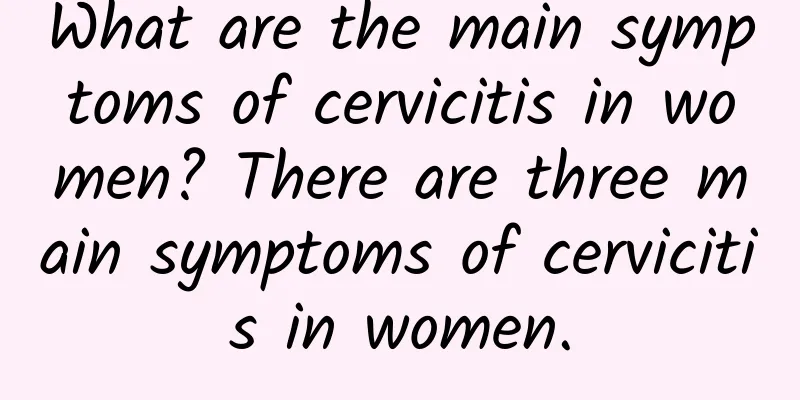What are the main symptoms of cervicitis in women? There are three main symptoms of cervicitis in women.

|
Cervicitis is the most common type of inflammation of the female reproductive organs, with a high incidence rate, accounting for more than half of married women. Cervicitis is a common gynecological inflammation in women of childbearing age. So what are the main symptoms of cervicitis? 1. Main symptoms of cervicitis Increased vaginal discharge, purulent, foul smell, mild dysmenorrhea, spotty menstruation; lower abdominal distension and discomfort, lower abdominal distension and pain, back pain, accompanied by frequent urination, urgency, sexual intercourse pain, lumbar pain, etc. If it is a gonococcal infection, the symptoms are more obvious, often with yellow purulent vaginal discharge, accompanied by acute urethritis, vaginitis, endometritis, varying degrees of fever and leukocytosis. 2. Acute cervicitis Acute cervicitis often occurs after childbirth or at the same time as acute pelvic inflammatory disease, and is often easily overlooked. In clinical practice, the most common is chronic cervicitis. In addition to increasing the pain of patients and affecting women's health, chronic cervicitis is also closely related to the occurrence of cervical cancer. 3. Chronic cervicitis Chronic cervicitis is mostly caused by local damage to the cervix during childbirth, abortion or surgery, which leads to bacterial infection. Insufficient hygiene during the postpartum and menstrual periods, or unclean sexual life can also bring bacteria into the reproductive tract and cause cervicitis. Cervical erosion is a common local feature of chronic cervicitis. Due to the infiltration of inflammatory secretions, the squamous epithelium of the cervix falls off and is replaced by the columnar epithelium of the cervical canal, which manifests as cervical erosion. The relationship between cervical abnormalities and pregnancy Cervical abnormalities can prevent semen from entering the cervix smoothly, affecting the entry of semen or sperm, and also affecting the normal storage of semen in the cervical canal. Therefore, once cervical lesions occur, female infertility is likely to occur. First: Clinical manifestations - cervical dysplasia It may be accompanied by uterine hypoplasia. Severely hypoplastic cervix is slender. Moderately hypoplastic cervix has a 1:1 ratio of uterine length to uterine body, which is the so-called "adolescent uterus". Cervical hypoplasia can lead to insufficient secretion of cervical glands. Second: Clinical manifestations - abnormal position of cervical canal It is often accompanied by abnormal position of the uterus. Chronic pelvic inflammatory disease or endometriosis can cause the uterus to be extremely retroverted, retroflexed or anteflexed, causing the external cervical os to stick to the anterior fornix, causing the posterior fornix to become shallow and lose its function as a sperm storage pool, which is not conducive to the upward movement of sperm. In addition, cervical elongation, excessive shortening or cervical prolapse may also change the normal positional relationship between the external cervical os and the posterior fornix, hindering the upward movement of sperm. Third: Clinical manifestations - cervical fibroids The main cause of infertility caused by cervical fibroids is deformation and stenosis of the cervical canal, which affects the passage of sperm. The main clinical manifestations are irregular menstruation, increased menstrual blood volume, increased leucorrhea, or bladder and rectal symptoms. Some patients are asymptomatic. Gynecological examinations can reveal protruding fibroid nodules in the cervix or changes in the appearance of the cervix. The cervix on the side where the fibroid is located is enlarged, while the opposite side is compressed and thinned, and the external opening of the cervix is stretched and flattened to form a twisted shape. Fourth: Clinical manifestations - cervical atresia and stenosis Congenital cervical atresia or stenosis is mostly caused by incomplete formation and fusion of the lower segments of bilateral Mullerian ducts. It is rare clinically and is often accompanied by uterine hypoplasia, and most secondary sexual characteristics develop normally. If the patient's endometrial function is good, periodic lower abdominal pain may occur during adolescence due to intrauterine blood accumulation, or scanty menstruation with dysmenorrhea. Menstrual blood can also flow back into the abdominal cavity through the fallopian tube, causing pelvic endometriosis. Acquired cervical atresia and stenosis are often seen after artificial abortion or after electrocautery and cryotherapy for cervicitis. The main reason is that the cervix is not fully dilated during suction, or the suction tube is removed with negative pressure, causing damage to the cervical endometrium and adhesion and closure of the wound surface. Electrocautery or cryotherapy for cervicitis treatment is too deep, resulting in adhesion or stenosis of the cervical canal. The clinical manifestations are amenorrhea with periodic lower abdominal pain after artificial abortion or treatment of cervicitis. Gynecological examination found that the vagina was purple-blue, the cervix was obviously painful, and the uterus was slightly full, active, and tender. |
<<: What are the causes of mild cervical erosion? 3 symptoms of mild cervical erosion in women
>>: Can cervicitis cause infertility in women? Women should do this to prevent cervicitis
Recommend
Women should be alert to the dangers of candidal vaginitis
Candidal vaginitis can be said to be a very commo...
Don't be afraid of Ashes of Time and West Poison. 4 tips to save money and detox
In order to maintain good health, regular detoxif...
Which department should I go to for abortion?
You can go to the obstetrics and gynecology depar...
How to eat New Year’s Eve dinner? Sausage with onion and garlic can prevent stomach cancer
As people’s health awareness rises, how should we...
What causes cervical hypertrophy?
What causes cervical hypertrophy? Experts say: Ce...
How to treat third-degree cervical erosion in women? How to treat third-degree cervical erosion in women?
How to treat third degree cervical erosion? Cervi...
What causes irregular menstruation after childbirth?
What causes irregular menstruation after childbir...
When is the right time to get the flu shot for adults?
It is generally best to get an adult flu shot bef...
Michelle loves to eat turnips to fight cancer and help the star lose weight
A few days ago, a video of Michelle Obama holding...
What if my period came 10 days early?
What if my period comes 10 days early? Menstruati...
Dietary care methods before uterine fibroid surgery What are the prevention methods for uterine fibroids
Speaking of uterine fibroid disease, I believe ev...
Can women with cervical erosion take medicine? 5 best ways to treat cervical erosion
With the development of medical technology, there...
Medical treatment of bacterial vaginosis
Bacterial vaginosis is a relatively common gyneco...
Daily body shaping exercises to improve OL's bad posture
Daily body shaping exercises to improve OL's ...
Will excessive sexual activity cause cervicitis? What are the hazards of chronic cervicitis?
Cervicitis is a common cervical disease, which ca...









